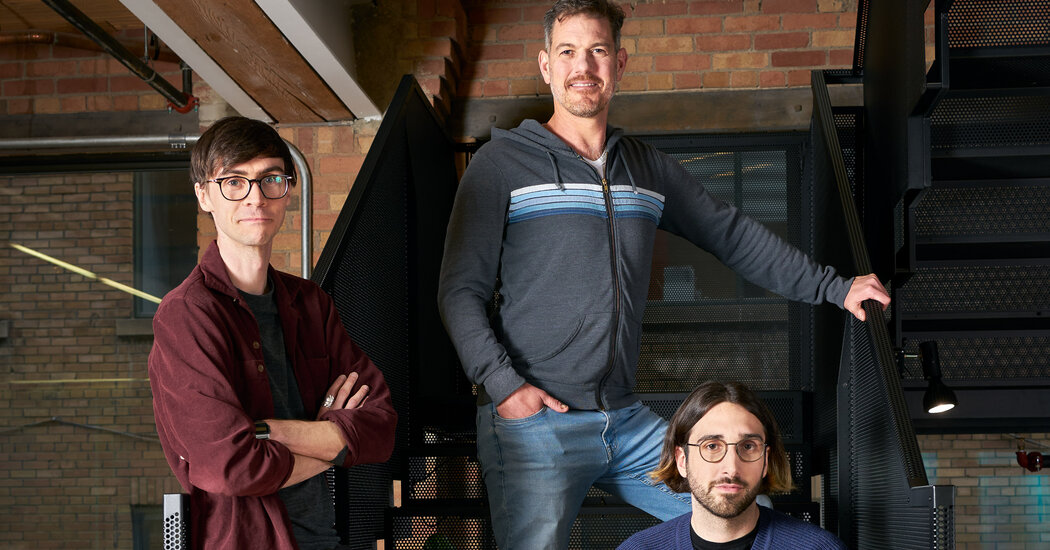The tech industry loves its garage start-up stories. From Hewlett-Packard to Google, the tales of bootstrapped companies that have turned into giants have inspired generations of entrepreneurs.
But the huge amounts of money and computing power needed for start-ups trying to make a go of it with today’s hottest technology, the artificial intelligence used in chatbots like ChatGPT and Google Bard, may be making those inspirational tales a thing of the past.
In 2019, Aidan Gomez and Nick Frosst left Google to create an A.I. start-up in Toronto called Cohere that could compete with their former employer. Several months later, they went back to Google and asked if it would sell them the enormous computing power they would need to build their own A.I. technology. After Google’s chief executive, Sundar Pichai, personally approved the arrangement, the tech giant gave them what they wanted.
“It’s ‘Game of Thrones.’ That’s what it is,” said David Katz, a partner with Radical Ventures, Cohere’s first investor. The big companies like Google, Microsoft and Amazon, he added, are controlling the chips. “They’re controlling the computing power,” he said. “They are selecting who gets it.”
Building a groundbreaking A.I. start-up is difficult without getting the support of “the hyperscalers,” which control the vast data centers capable of running A.I. systems. And that has put the industry’s giants in the driver’s seat — again — for what many expect to be the most important shift for the tech industry in decades.
OpenAI, the start-up behind ChatGPT, recently raised $10 billion from Microsoft. It will pump most of that money back into Microsoft as it pays for time on the massive clusters of computer servers operated by the bigger company. Spanning thousands of specialized computer chips, these machines are essential to improving and expanding the skills of ChatGPT and similar technologies.
Competitors cannot keep pace with OpenAI unless they get their hands on similar amounts of computing power. Cohere recently raised $270 million, bringing its total funding to more than $440 million. It will use much of that money to buy computing power from the likes of Google.
Other start-ups have made similar arrangements, most notably a Silicon Valley company called Anthropic, which was founded in 2021 by a group of former OpenAI researchers; Character.AI, founded by two leading researchers from Google; and Inflection AI, founded by a former Google executive. Inflection raised a $1.3 billion funding round last week, bringing its total to $1.5 billion.
At Google, Mr. Gomez was part of a small research team that designed the Transformer, the fundamental technology used to create chatbots like ChatGPT and Google Bard.
The Transformer is a powerful example of what scientists call a neural network — a mathematical system that can learn skills by analyzing data. Neural networks have been around for years, helping to drive everything from talking digital assistants like Siri to instant translation services like Google Translate.
The Transformer took the idea into new territory. Running across hundreds or even thousands of computer chips, it could analyze far more data, far more quickly.
Using this technology, companies like Google and OpenAI began building systems that learned from enormous amounts of digital text, including Wikipedia articles, digital books and chat logs. As these systems analyzed more and more data, they learned to generate text on their own, including term papers, blog posts, poetry and computer code.
These systems — called large language models — now underpin chatbots like Google Bard and ChatGPT.
Well before the arrival of ChatGPT, Mr. Gomez left Google to start his own company alongside Mr. Frosst and another Toronto entrepreneur, Ivan Zhang. The aim was to build large language models rivaling Google’s.
At Google, he and his fellow researchers had access to nearly unlimited amounts of computing power. After leaving the company, he needed something similar. So he and his co-founders purchased it from Google, which sells access to the same chips through cloud computing services.
Over the next three years, Cohere built a large language model that rivals almost any other. Now, it is selling this technology to other businesses. The idea is to provide any company with the technology they need to build and run their own A.I. applications, from chatbots to search engines to personal tutors.
“The strategy is to build a platform that others can build off of and experiment with,” Mr. Gomez said.
OpenAI offers a service along the same lines called GPT-4, which many businesses are already using to build chatbots and other applications. This new technology can analyze, generate and edit text. But it will soon handle images and sounds as well. OpenAI is preparing a version of GPT-4 that can examine a photograph, instantly describe it and even answer questions about it.
Microsoft’s chief executive, Satya Nadella, said the company’s arrangement with OpenAI is the kind of mutually beneficial relationship that it has long nurtured with smaller competitors. “I grew up in a company that has always done these types of deals with other companies,” he told The New York Times earlier this year.
As the industry races to match GPT-4, entrepreneurs, investors and pundits are debating who will be the eventual winners. Most agree that OpenAI is leading the field. But Cohere and a small group of other companies are building similar technology.
The tech giants are in a strong position because they have the vast resources needed to push these systems further than anyone else. Google also holds a patent on the Transformer, the foundational technology behind the A.I. systems that Cohere and many other companies are building.
But there is a wild card: Open source software.
Meta, another giant with the computing power needed to build the next wave of A.I., recently open sourced its latest large language model, meaning anyone can reuse it and build on top of it. Many in the field believe this kind of freely available software will allow anyone to compete.
“Having the collective minds of every researchers on Earth would beat any company,” said Amr Awadallah, chief executive of the A.I. start-up Vectara and a former Google executive. But they’ll still need to pay for access to a much larger competitor’s data centers.



